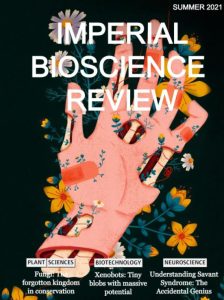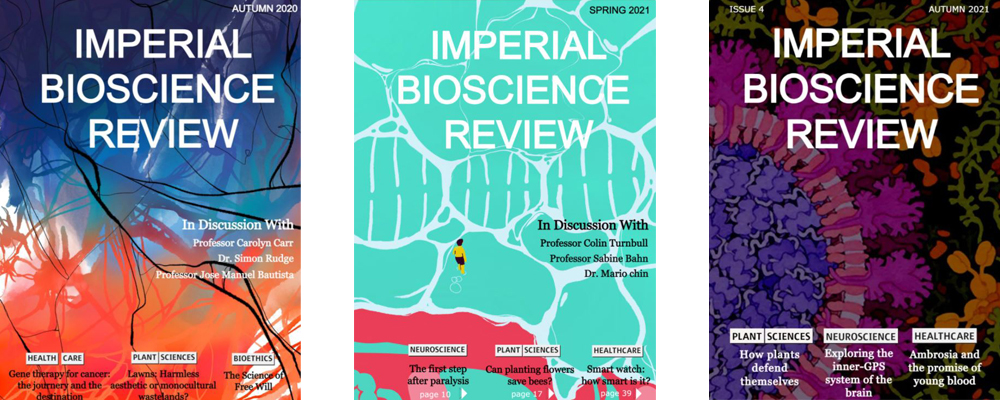The Imperial Bioscience Review (IBR) is a student-led project, publishing articles on emergent and established fields of bioscience. The team aims to remove barriers to science by providing accurate, up-to-date, unbiased and inclusive articles that are free-to-access.
Life Sciences undergraduate student, Andres Hernandez Maduro, is a contributor. In this post he shares insights into IBR’s editorial and publishing process, and why it’s such a rewarding role alongside his curricular studies.
By Andres Hernandez Maduro
Sci comm and collaboration
Imperial Bioscience Review (IBR) published pieces are short, evidence-based summaries of topics that interest student contributors – and these articles are made freely available online. Since its inception just over a year ago, IBR has extended its base to over 100 writers across several undergraduate and postgraduate courses. With articles published online on a weekly basis, the collection of work has quickly grown to over 400 review pieces. In addition, IBR produces a termly magazine to showcase our writers’ work to the college community, kindly supported by the Department of Life Sciences.
Alongside our standard publishing activity, IBR also engages and collaborates with other groups to create content that relates to the scientific interest of our writers. Recent partners include the Center for Vascular Emergencies (CVE), a group based at Massachusetts General Hospital, and Harvard University.
Through the eyes of a student writer
I first began working with IBR to build my writing experience, hoping to pursue future opportunities as a bachelor research assistant. While this is still true, it now only forms part of my motivation. Over the months at Imperial, working with my editor and the other contributing writers at IBR has been an incredibly enjoyable experience. Reading through my peers’ articles, I have learnt about a multitude of disciplines. This is largely due to the huge variety of Life Scientists at IBR, spanning year groups and courses across the university. The sizable student base and shared interests of writers at IBR further makes for an extensively connected network, into which I was able to integrate both professionally and socially. In turn, this has resulted in connections that I have no doubt will continue to make student life at Imperial a pleasure.
 Writing with IBR fits very well into my schedule as a student. Often, my writing even provides a useful method to revise and explore my course material. One of my own articles, for instance, was an in-depth review into the assembly and locomotion of bacterial flagella. Since this was still a core topic in my course’s Microbiology section at the time, it proved to be remarkably helpful when recollecting facts and outside reading for my exams. Of course, it is not necessary whatsoever to tie your articles into your degree – and built into IBR’s principles is complete freedom to explore the biosciences as you wish. With the assistance of IBR’s editors, you can further apply your voice and opinions into state-of-the-art research, building familiarity with many fields of study. This is particularly useful for exploring which scientific areas you may want to pursue in the future.
Writing with IBR fits very well into my schedule as a student. Often, my writing even provides a useful method to revise and explore my course material. One of my own articles, for instance, was an in-depth review into the assembly and locomotion of bacterial flagella. Since this was still a core topic in my course’s Microbiology section at the time, it proved to be remarkably helpful when recollecting facts and outside reading for my exams. Of course, it is not necessary whatsoever to tie your articles into your degree – and built into IBR’s principles is complete freedom to explore the biosciences as you wish. With the assistance of IBR’s editors, you can further apply your voice and opinions into state-of-the-art research, building familiarity with many fields of study. This is particularly useful for exploring which scientific areas you may want to pursue in the future.
The guidelines for IBR articles are relaxed, allowing writers to have as much creative freedom as possible. The main requirement is good sourcing of information with accurate referencing – all of which ties into a key tenet of IBR, which is to ensure that we provide informed accounts of a topic or concept. Once a writer has their draft article, they work together with their editor to review the piece and produce a final version. I have found this to be good practice for both individual and group academic work – but also great fun, given how rewarding it is to work with the IBR team!
After publishing an article, it becomes freely available online for anyone to read. If you frequently read any magazine outside Imperial (e.g., The Economist, Nature, or the RSC), this might seem somewhat strange to you, given that most tend to come with a membership fee. However, IBR aims to have its content accessible to people of all backgrounds – with no paywall to prevent this.
Projects, policy and partnerships
IBR provides opportunities to engage with projects relating to science and health policy. Through The Haldane Group, a recently launched student think-tank at IBR, writers can explore how emergent research might be translated into action at the government or local level. Recent reports published as part of this group look at how COVID-19 may be mitigated in India, and how reforestation strategies should be undertaken in Brazil. This group provides an avenue for probing how science intersects with policy and builds experience for students who seek to enter public health and policy fields.
Partnerships with external groups, such as the collaboration with the CVE at Massachusetts General Hospital, allow students to investigate topics of interest alongside field experts. The CVE partnership involves a smaller team of IBR writers who produce content relating to vascular emergencies. This transatlantic partnership will continue in the future, producing additional multimedia work and providing an invaluable experience for our writers at IBR. Altogether, these opportunities give IBR an incredibly dynamic nature – and there are always exciting new projects that students can get involved in!
Find out more
- Students – are you interested in joining as a writer? Get in touch to find out how to join the team!
- Visit the Imperial Bioscience Review website to access articles
- Explore undergraduate and postgraduate taught courses, and postgraduate research opportunities in the Department of Life Sciences
